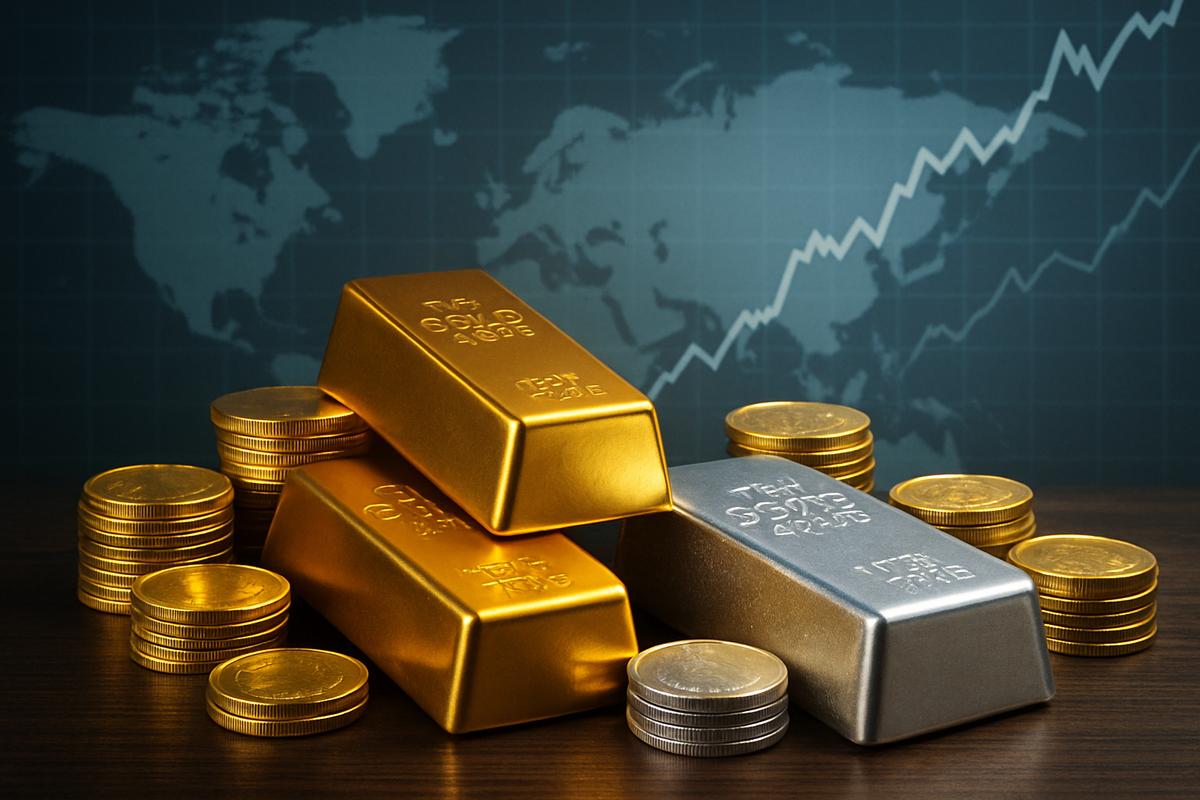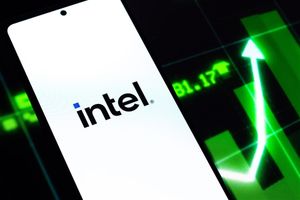
On October 17, 2025, the global financial markets witnessed an extraordinary surge in precious metal prices, with the Multi Commodity Exchange (MCX) Gold December contract reaching an unprecedented intraday high of ₹1,32,294 per 10 grams. This historic rally, mirrored by the February 2026 gold contract hitting ₹1,34,024 and the silver December futures contract soaring to a record ₹1,70,415 per kilogram, signals a pronounced "flight to safety" as investors navigate a landscape fraught with escalating global economic uncertainties and geopolitical tensions. The immediate implications are a significant re-evaluation of portfolio strategies, a heightened "risk-off" sentiment, and a renewed affirmation of gold and silver's critical role as ultimate safe-haven assets.
The dramatic ascent of gold and silver prices on this pivotal day underscores a deepening investor apprehension towards traditional financial instruments, prompting a decisive shift towards tangible assets. This monumental price movement not Pre-ownedly reflects immediate market reactions to prevailing global instability but also sets a new benchmark for precious metals, challenging conventional valuations and signaling potentially transformative shifts in investment paradigms for the foreseeable future.
Unpacking the Historic Precious Metals Rally of October 2025
The record-breaking surge in gold and silver prices on October 17, 2025, was a culmination of several powerful, interconnected global and domestic factors. Specifically, the MCX Gold December contract's climb to ₹1,32,294 per 10 grams and the silver December futures contract's rise to ₹1,70,415 per kilogram were driven by a confluence of geopolitical instability, economic anxieties, and strategic financial shifts. In the international arena, spot gold breached the $4,300 per ounce threshold, with COMEX gold futures touching approximately $4,289.90, while silver remarkably surpassed its 1980 and 2011 peaks to exceed $54 per ounce.
The timeline leading up to this moment has been characterized by persistent global unease. Intensifying US-China rivalry and ongoing concerns surrounding US-Russia relations have fostered an environment of geopolitical tension, eroding investor confidence in conventional assets. Simultaneously, lingering anxieties about the U.S. economy, marked by "US credit worries" and vulnerabilities within the U.S. regional banking sector, have rekindled fears about the broader financial system's stability. A significant contributing factor has been the strong market expectation of aggressive interest rate cuts by the US Federal Reserve, making non-yielding gold a more attractive investment. This dovetailed with a depreciating US dollar, further enhancing gold's appeal for international investors.
Key players in this market movement include central banks and global funds, which have been consistently accumulating gold reserves as a hedge against inflation and market volatility. This trend reflects a strategic "de-dollarization" effort, particularly among BRICS nations, further bolstering demand. Domestically, in India, robust demand ahead of the festive season, especially Dhanteras, played a crucial role in amplifying the price surge. The pervasive "flight to safety" sentiment, coupled with investor "Fear Of Missing Out" (FOMO), provided additional momentum. For silver, a "structural bull market" driven by surging demand from the green economy, coupled with limited mine supply and dwindling above-ground inventories, has been a significant catalyst, with industrial demand now accounting for nearly 60% of its consumption. Initial market reactions have been a mix of exhilaration among holders of precious metals and caution from analysts, who advise partial profit-booking and waiting for corrections before new purchases, while acknowledging the strong underlying bullish sentiment.
Companies Navigating the Golden Tide: Winners and Losers in the Precious Metals Boom
The historic surge in gold and silver prices on October 17, 2025, with MCX Gold December contracts breaching ₹1.32 lakh and silver hitting ₹1.70 lakh, creates a clear delineation of winners and losers across various public companies. This unprecedented rally is set to profoundly impact the profitability, stock performance, and operational strategies of entities involved in precious metals mining, jewelry retail, and industrial applications of silver.
Gold and silver mining companies stand as the unequivocal primary beneficiaries. Higher commodity prices directly translate into augmented revenues and expanded profit margins, assuming production costs remain relatively stable. This operating leverage often leads to robust cash flows, increased exploration budgets, and the viability of previously uneconomic deposits. Giants like Newmont Corporation (NYSE: NEM) and Barrick Gold Corporation (NYSE: GOLD), as leading global gold producers, are poised for substantial gains. Their extensive reserves mean that every increase in the per-ounce price significantly inflates the value of their in-ground assets and current production, potentially leading to higher dividends and strong stock performance. Similarly, major silver producers such as Pan American Silver Corp. (NASDAQ: PAAS), First Majestic Silver Corp. (NYSE: AG), and Hecla Mining Company (NYSE: HL) will see their profitability skyrocket, leading to increased exploration and stronger balance sheets. Precious metals streaming and royalty companies like Wheaton Precious Metals Corp. (NYSE: WPM) and Franco-Nevada Corporation (NYSE: FNV) also stand to "win big," as the value of their fixed-cost purchases of future production dramatically increases without direct exposure to mining risks.
Conversely, the sharp escalation in gold and silver prices presents significant challenges for jewelry companies. The cost of raw materials, which forms a substantial portion of their product costs, will inevitably lead to higher retail prices. This can subsequently dampen consumer demand for discretionary purchases like jewelry, squeezing profit margins, especially for companies with already thin margins. Signet Jewelers Limited (NYSE: SIG), the world's largest diamond jewelry retailer, operating brands like Kay Jewelers and Zales, will face considerable pressure. While focusing on diamonds, gold and silver are crucial for settings, and skyrocketing metal costs will inflate material expenses. Signet may need to absorb these costs, impacting profitability, or pass them on, potentially reducing sales volume for gold and silver items. Their strategy might involve emphasizing alternative metals or promoting pre-owned pieces. Pandora A/S (CPH: PNDORA), known for its silver-based charm bracelets, will be heavily impacted by the surge in silver prices, necessitating pricing adjustments that could affect competitiveness and demand. Even luxury conglomerates like LVMH Moët Hennessy Louis Vuitton (EPA: MC), with brands such as Tiffany & Co. and Bulgari, will face increased raw material costs in their Watches & Jewelry sector, though their strong brand loyalty might allow for more effective price transmission to affluent clientele.
Companies heavily reliant on silver for industrial use will also contend with significant cost pressures. Silver's superior electrical and thermal conductivity makes it indispensable in electronics, solar panels, and electric vehicles, often making demand inelastic despite price spikes. First Solar, Inc. (NASDAQ: FSLR), a leading solar panel manufacturer, will see its production costs directly increase due to silver's critical role in photovoltaic cells. This forces a difficult choice between absorbing costs, impacting margins, or passing them on, potentially affecting its competitiveness. Major electronics producers such as Apple Inc. (NASDAQ: AAPL) and Samsung Electronics Co., Ltd. (KRX: 005930), while diversified, use vast quantities of silver in circuit boards and components. The sheer volume means a significant price increase translates into higher manufacturing expenses, leading to margin pressure and potential product price adjustments. Similarly, electric vehicle manufacturers like Tesla, Inc. (NASDAQ: TSLA) and General Motors Company (NYSE: GM) will face higher material costs for their rapidly expanding EV production, adding to overall manufacturing expenses and potentially impacting profit margins. These industrial users will need to focus on supply chain resilience, cost optimization, and potentially intensified research into less silver-intensive technologies.
Broader Implications and a Shifting Global Landscape
The monumental surge in gold and silver prices on October 17, 2025, extends far beyond mere commodity market movements, signaling profound shifts in the global financial and economic landscape. This rally, with the MCX Gold December contract hitting ₹1.32 lakh and silver reaching ₹1.70 lakh, is not an isolated incident but a powerful manifestation of several interconnected broader industry trends, creating ripple effects across various sectors and potentially prompting significant regulatory and policy considerations.
At its core, this surge underscores an accelerating "flight to safety" amidst pervasive global uncertainty. Escalating geopolitical tensions, including an intensified US-China rivalry and ongoing conflicts in Eastern Europe and the Middle East, coupled with persistent concerns about the stability of the global financial system and a noticeable erosion of confidence in fiat currencies, are driving investors towards tangible assets. This trend is further fueled by persistent global inflation and strong expectations of interest rate cuts by major central banks, particularly the US Federal Reserve, which diminishes the opportunity cost of holding non-yielding precious metals. A significant structural trend is the accelerating "de-dollarization" movement, with central banks worldwide consistently increasing their gold holdings to diversify reserves away from the US dollar, providing robust, long-term support for gold prices. For silver, robust industrial demand, especially from the rapidly expanding green energy sector (solar panels, electric vehicles) and electronics, is a critical driver. Industrial use now accounts for approximately 59% of silver demand, which is largely inelastic, meaning industries prioritize supply security even at higher costs, leading to structural supply deficits.
The ripple effects of this price surge are extensive. While gold and silver mining companies are poised for increased profitability and cash flows, incentivizing higher production and exploration, industries reliant on silver face significant challenges. The jewelry sector, for instance, will contend with sharply rising material costs, potentially leading to higher retail prices, dampened consumer demand, and margin compression. Financial institutions and investors are reassessing portfolio allocations, with a noticeable "21st Century Gold Rush" seeing robust inflows into gold and silver-backed ETFs. However, industrial users of silver in electronics and solar energy face higher input costs, which could eventually lead to "thrifting" or the search for alternative materials, despite the technical limitations of substituting silver's unique properties. Commodity exchanges like MCX will likely see increased trading volumes and volatility, potentially inviting heightened scrutiny from regulatory bodies to monitor for speculative activities or market manipulation.
Historically, the current rally shares similarities with the post-Bretton Woods gold surge of the 1970s, driven by high inflation and economic uncertainty, and the safe-haven demand seen during the 2008 Global Financial Crisis. However, the present situation is distinguished by the unprecedented scale of central bank gold accumulation, the severity of silver's backwardation indicating fundamental supply issues, and the intensified geopolitical fragmentation and de-dollarization trends. Regulatory implications could include central bank monetary policy adjustments to address underlying economic conditions, increased market surveillance to prevent manipulation, and potential revisions to fiscal policies in mining jurisdictions. The sustained and dramatic nature of this rally suggests a more fundamental re-evaluation of global economic structures and a long-term shift towards tangible assets as a hedge against systemic risks.
What Comes Next: Navigating the Future of Precious Metals
The historic surge in gold and silver prices on October 17, 2025, with the MCX Gold December contract hitting ₹1.32 lakh and silver reaching ₹1.70 lakh, marks a pivotal moment in financial markets, setting the stage for significant short-term and long-term possibilities. While the immediate bullish momentum is expected to continue, market participants must remain agile, adapting their strategies to capitalize on emerging opportunities and mitigate potential challenges in this new precious metals paradigm.
In the short term, the bullish trend for both gold and silver is largely anticipated to persist, fueled by ongoing geopolitical tensions, persistent inflation fears, expectations of U.S. Federal Reserve rate cuts, and robust festive demand in India. However, the current overbought conditions suggest a high probability of short-term pullbacks or consolidation phases. These dips, if they occur, are widely viewed as healthy corrections and fresh buying opportunities for investors. Gold is expected to consolidate between $4,280 and $4,400 per ounce before attempting further breakouts, with some forecasts suggesting it could reach $4,400 by year-end 2025. Silver, having surpassed its historical peaks, may retest support levels before targeting $54.50 and potentially $60-$65 per ounce. Increased volatility should be expected as markets react to fluid global events and profit-taking activities.
Looking further ahead, the long-term outlook for gold and silver remains overwhelmingly bullish, with the current rally seen as a "structural bull case" rather than a speculative bubble. Persistent inflation, continued central bank gold accumulation, ongoing geopolitical risks, and robust industrial demand for silver are expected to keep prices elevated for years to come. J.P. Morgan Research anticipates gold averaging $3,675/oz by Q4 2025 and climbing towards $4,000/oz by mid-2026, with other projections seeing it potentially surpassing $5,000 per ounce within a few years, or even $10,000 by 2031 under certain high-inflation scenarios. For silver, forecasts range from $30-$40 per ounce in 2025 to $65 by 2026, with some analysts predicting it could reach $88 before 2028, or even $100-$240 in the long run, driven by structural supply deficits and surging demand from green technologies.
Strategic pivots will be crucial for market participants. Investors are encouraged to diversify their holdings beyond physical metal to include Gold and Silver ETFs and Sovereign Gold Bonds (SGBs) for enhanced liquidity and ease of management. A long-term investment horizon, coupled with a "buying on dips" strategy, will be key to maximizing gains. Closely monitoring global geopolitical developments, U.S. Federal Reserve policy, and the U.S. dollar's strength will be essential. A notable shift is the growing institutional acceptance of precious metals as a core portfolio component, with some major financial institutions recommending a "60/20/20" portfolio structure (60% equities, 20% bonds, 20% gold). Jewelers will need to adapt by diversifying their offerings to include more investment-grade coins and bars, while industrial users of silver will focus on supply chain resilience and potentially intensified research into less silver-intensive technologies. Emerging market demand, particularly from China and India, will continue to play a significant role in supporting prices, though physical supply shortages, especially for silver, pose a challenge.
A Golden Horizon: Assessing the Enduring Impact of the Precious Metals Surge
The unprecedented surge in gold and silver prices on October 17, 2025, culminating in the MCX Gold December contract's climb to ₹1.32 lakh and silver's ascent to ₹1.70 lakh, marks a defining moment in the financial markets, underscoring a profound re-evaluation of global economic stability and investment paradigms. The key takeaway from this event is the unequivocal reaffirmation of gold and silver as ultimate safe-haven assets amidst a landscape of escalating geopolitical tensions, persistent inflationary pressures, and a discernible shift towards de-dollarization by central banks worldwide. This rally is not merely a transient spike but indicative of a deeper, structural bull market driven by fundamental economic and geopolitical forces.
Moving forward, the market is expected to remain highly dynamic and volatile, yet with a strong underlying bullish bias for precious metals. The confluence of factors that propelled this surge – including the anticipation of U.S. Federal Reserve rate cuts, a weakening U.S. dollar, and robust industrial demand for silver, especially from the green energy sector – are anticipated to continue providing significant tailwinds. While short-term corrections are a natural and healthy part of any bull market, offering strategic entry points for long-term investors, the overarching sentiment points towards sustained price appreciation for both gold and silver in the coming months and years.
The lasting impact of this event will likely be a fundamental shift in investor psychology and portfolio construction. The traditional 60/40 equity-bond portfolio is increasingly being challenged, with a growing recognition of precious metals as an essential component for diversification and wealth preservation. This institutional mindset shift, coupled with continued retail interest, solidifies the position of gold and silver as critical assets in an uncertain world. The challenges for industries heavily reliant on silver will prompt innovation in material science and supply chain management, while mining companies will be incentivized to increase exploration and production.
Investors in the coming months should closely watch for key indicators: further developments in global geopolitical conflicts, any shifts in central bank monetary policies (particularly from the U.S. Federal Reserve), the trajectory of inflation rates, and the strength of the U.S. dollar. For Indian investors, monitoring the rupee's performance against the dollar and domestic festive demand will also be crucial. While the allure of quick gains may be tempting, a disciplined, long-term approach, coupled with strategic buying on dips and diversification across various precious metal instruments, will be paramount to navigating this exciting yet volatile market. The golden horizon appears bright, but informed caution and strategic foresight will be the investor's most valuable assets.
This content is intended for informational purposes only and is not financial advice





